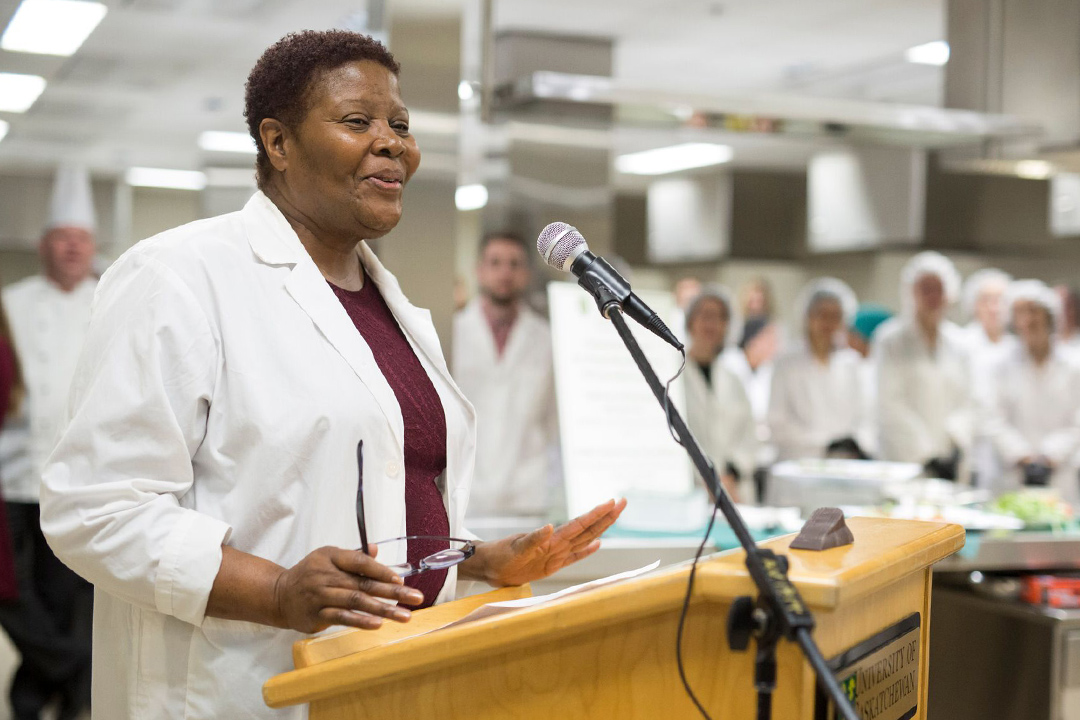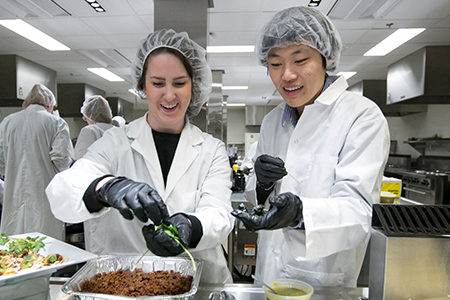
New nutrition lab feeds research needs
For Carol Henry, one word can open up a lot of doors.
By Lesley Porter“Food—just that one term generates so many things,” said Henry, the assistant dean of nutrition and dietetics, as well as a professor within the division.
The subject of food is at the forefront of the College of Pharmacy and Nutrition’s undergraduate food lab, newly-opened on March 3 in the B-wing of the Health Sciences Building.
Complete with a large commercial kitchen comprised of 24 cooking and prep stations, adjacent research space and seminar rooms, a commercial dishwasher, and an expansive storage area with a walk-in fridge and freezer, the space provides students with a modern environment to practice their skills in nutrition research and food service training.
First and foremost, Henry explained, the lab has to be a training ground for students, tackling the hands-on skills needed for a career in nutrition and dietetics—such as creating modified meal plans or safely wielding a kitchen knife.

“But we also want, through our programs, for it to be an outreach into the communities,” she continued. While “we haven’t figured all of this out yet,” she noted that organizations such as the Friendship Inn may benefit from the lab’s “planned overages” through donations of food.
“As it benefits students, it could also benefit the community at large,” she said. “It has to do both.”
Thinking at a macro level, Henry hopes the lab also encourages students to think more critically about the role of food in society.
Speaking passionately about global food systems and health promotion, she sees the potential for the lab to address issues of food security locally, nationally and even internationally. Henry used a common household staple—milk—as an example.
“The carton I get here for four or five dollars, up north, is 13 dollars. So when I talk to northern residents about healthy eating, how do you get around that?”
The issue permeates further to developing countries like Ethiopia and Uganda, where Henry has also done considerable research on food security and food systems.
“All of this impacts the person’s health and their ability to get food,” she continued, “so we have to address all of those.”
Fortunately, when it comes to food research, there are many interdisciplinary connections to be made. While research and education links within the health sciences make sense, “we’re also connected to the College of Agriculture and Bioresources—because we have to eat food,” said Henry.
Similar links exist with the College of Kinesiology.
“When you look at health, the environment, nutrition and physical activity, there’s a natural link there as well,” she said.
The new lab will replace its smaller predecessor in the basement of the Thorvaldson Building, constructed for the now-defunct College of Home Economics. The older lab could only accommodate a maximum of 12 students, Henry explained, which impacted the curriculum as lab time had to be broken up throughout the week. The new larger lab, however, accommodates more people so the lab time can be held on one day, “and with that timeslot we can do a lot more.”
“When we were in the basement of Thorvaldson, we saw potential to this level,” she said. “But now as we sit here and look out there, we can see greater potential of how this concept of food and the practical application of it can bring several disciplines to address food security in Saskatoon, the province and elsewhere.”

